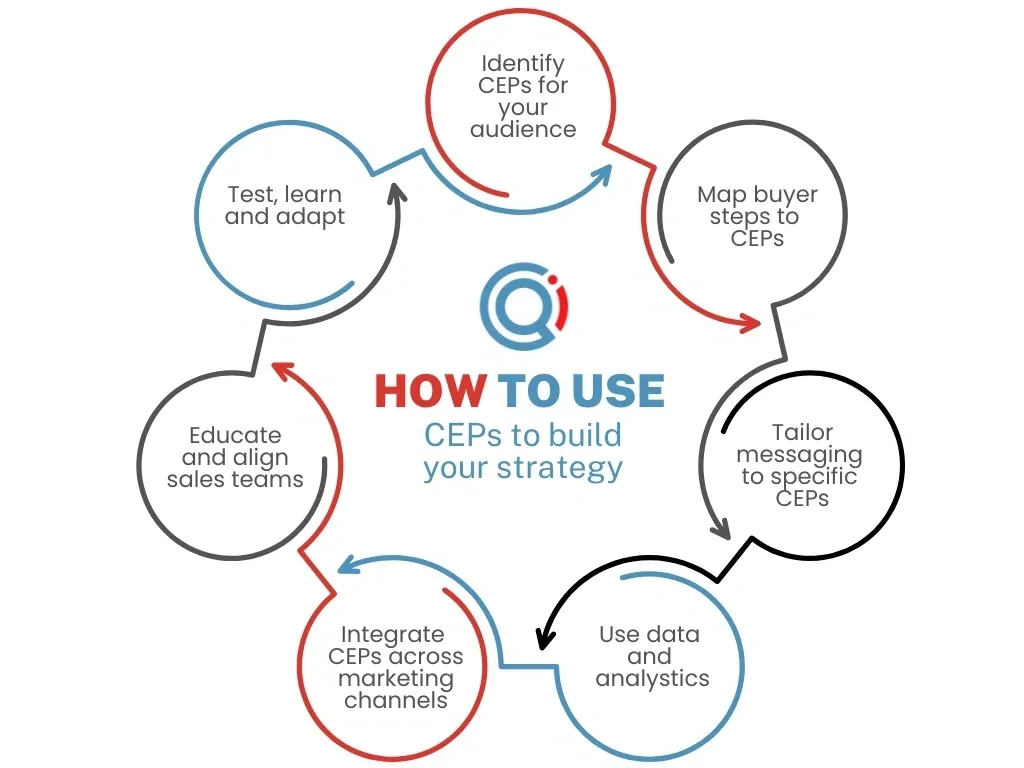Marketing in the Life Sciences, Biotech, and MedTech industries involves targeting consortia of highly specialised audiences with varying and specific needs. With budgets tightening and pressure to deliver tangible results rising, science marketers need to optimise their efforts to ensure a steady flow of leads through the funnel. So how can you ensure that your brand comes to mind when a science buyer is ready to purchase? One key strategy to achieving this is by leveraging Category Entry Points (CEPs). Let us quickly explain why this isn’t just marketing jargon…
What are buyer category entry points (BCEPs)?
CEPs are the contextual triggers or situations that category buyers use to access their memories when faced with a buying situation. Although each category buyer and buying situation is unique, there are recurring patterns – aka the CEPs. These CEPs shape which brands come to mind first for decision-makers, forming their initial list of preferred options. By understanding your target audience’s CEPs, you can establish meaningful connections between your brand and the key buying scenarios within the category. This increases the likelihood that your brand will be top-of-mind when a buyer considers a purchase, which is the critical first step toward securing a sale.
In Life Sciences, Biotech, or MedTech, CEPs might include a researcher’s need for high-purity reagents for a time-sensitive experiment or a lab manager seeking cost-effective consumables. Mapping these triggers enables marketers to craft targeted messages that address their audience’s immediate needs, ensuring their brand remains memorable when decisions are made. Crucially, it can help allocate budget towards advertising and messaging activity that is directly associated with building brand awareness aligned to the CEPs.
Professor Jenni Romaniuk, who wrote the book on what she calls “Category Entry Points” (CEPs) explains: “There are lots of ways people enter a category; we want to be behind as many of those doors as possible. That’s the probability game at play.” Research from the Ehrenberg-Bass Institute shows that aligning messaging with specific buying situations can boost brand salience by 10% and improve lead conversion rates by 15%. [1] Moreover, studies indicate that fewer BCEPs associated with a brand increase the likelihood of customer churn, underscoring the importance of CEPs in fostering loyalty.
So, how can science marketers harness CEPs to create smarter and more impactful strategies?

Importance of CEPs in lead generation

Linking your marketing to CEPs is essential because they make your brand relevant when it matters most, turning casual awareness into action. Ehrenberg-Bass research proves it: brands that connect their messaging to real buying situations dominate in salience and market share. And in Life Sciences, where decisions hinge on specific research needs or strict regulations, getting this right isn’t optional. It’s also worth remembering that in this sector, there are between 6-10 decision makers to cater to, so your CEPs should ideally cater for all of the different roles that bear weight on a B2B buying decision. In a decision to buy a new benchtop instrument for a lab for example, you will typically find that a lab manager, a Principal Investigator (PI), a procurement person, technical staff, the finance department, and a Quality Assurance officer at the bare minimum will be making an assessment and conducting product research. In smaller companies a CEO and CTO/CSO/CMO will be involved. Moreover research notes that the B2B buyer is also balancing business objectives with their personal preferences and ambitions [1], which makes it all the more important to understand which behavioural and environmental triggers bear influence on their day-to-day.
Take Thermo Fisher Scientific. They know researchers are under pressure to deliver results, so they hammer home messages around the reliability of their reagents and scalability for drug development workflows. Bio-Rad? They lean hard into solving lab scientists’ biggest headache of reproducibility and ease of use by positioning their products as the go-to tools for hassle-free experiments.
These brands don’t just show up; they own the moment when customers are ready to act. That’s the power of CEPs. If your marketing messages aren’t speaking directly to these pivotal buying triggers, you’re simply leaving leads-and market share on the table.
How to use this approach in your strategic planning
- Identify relevant CEPs: Make sure that when you carry out market research, you also take the time to understand the various situations that prompt potential customers to seek products or services in your category. Dedicate at least one question in your research specifically to that. To start with, you can analyse customer inquiries, feedback, and purchasing patterns.
- Rank the CEPs: Not all entry points are equally significant. Determine which CEPs are worthwhile going after and structure your marketing plan accordingly. This is because some buying situations are less valuable, less relevant to your ICPs or are likely to generate lower revenue. For example, time-sensitive problem solving is a common CEP – a lab manager might need same-day delivery of antibodies after discovering a supply shortage, so your marketing messaging should highlight rapid delivery, 24/7 support, real-time stock availability or global supplier network that customers can tap into. Example messaging might be: “Get critical reagents delivered overnight, because your research can’t wait.” A more valuable CEP in the Life Sciences might be illustrated by the needs of a biotech company wanting to scale up for clinical trials. In this case messaging around scalable solutions for every phase, from research to commercial production and around robust supply chains is highly likely to land you warm leads.
- Tailor marketing messages: Develop content and campaigns that directly address the identified CEPs. For example, if a common entry point is the need for compliance with new regulations, create content that highlights how your product ensures compliance. For example, biotech startups often need ISO-certified lab equipment to satisfy regulatory requirements for scaling up production. In this case, you can focus on certifications, compliance guarantees, and endorsements from regulatory bodies. Messaging like this will go down well: “Our instruments meet FDA and ISO standards ensuring every result stands up to scrutiny.”
- Train your sales team: Ensure that your sales team is aware of the identified CEPs and that they are equipped to discuss how your offerings meet these specific needs. Ideally, having a single statement developed for each critical CEP for your ICPs can be really helpful to ensure that marketing and sales teams are perfectly aligned.

Not without some challenges
Implementing a CEP-focused strategy can also present some challenges that are worth noting.
- Ensuring accurate CEPs are used: Misidentifying entry points can lead to ineffective marketing. To avoid this situation, conduct regular market research and gather direct feedback from customers and your sales teams to refine your understanding and note any shifts in the CEPs.
- Resource allocation: It is important to have multiple creatives, each tapping into a different category entry point because you can’t link your brand to every buying situation in a single headline or tactic. Focusing on multiple CEPs is likely to strain resources, so it will be important to prioritise the CEPs that are used to build tactics and messaging around.
- Consistency across channels: Keeping messaging consistent across various marketing channels can be challenging, so it is worth taking the time to develop a unified marketing strategy that outlines how each CEP will be addressed across different platforms.
And what about measurement?
One of the biggest challenges in leveraging BCEPs effectively is measuring brand awareness accurately, since situations, contexts, needs and triggers that prompt buyers to recall a particular brand are difficult to observe directly. This makes the data collection process nuanced and highly-challenging. Many marketers rely on “correlated metrics” as proxies for brand awareness, but ensuring these metrics truly reflect awareness is critical. To do this in B2B, it is essential to understand what these potential correlated metrics for brand awareness might be, and to have the confidence that they actually contribute to brand awareness.
So what are these correlated metrics? They are measurable indicators that align closely with changes in brand awareness (even if they don’t directly measure it) and include:
- Search volume: An increase in branded keyword searches on search engines can suggest heightened brand awareness.
- Social media mentions: A rise in organic mentions of your brand across platforms often signals growing familiarity.
- Website traffic: Particularly direct traffic or traffic from organic search, as it may indicate people know your brand name and seek it out.
- Share of voice (SOV): The percentage of industry-related conversations or ad impressions that include your brand versus competitors.
- Survey data: Metrics like unaided or aided brand recall collected through consumer surveys.

Not all metrics that seem related to brand awareness genuinely are, so validation is essential. Here’s how to ensure correlation:
- Longitudinal analysis: Track the relationship between the correlated metric and brand awareness over time. For instance, compare search volume trends with brand recall survey data. If both increase or decrease in tandem, it indicates a potential correlation.
- Controlled experiments: Run campaigns designed to increase brand awareness and measure the change in both direct awareness metrics (e.g., surveys) and correlated metrics (e.g., search volume). A strong, consistent relationship between the two confirms validity.
- Cross-validation: Compare multiple correlated metrics (e.g., search volume and SOV) to see if they trend similarly when brand awareness changes, adding a layer of reliability to your findings.
- Statistical analysis: Use correlation coefficients or regression analysis to quantify the relationship between the metric and direct brand awareness measures. A strong statistical correlation suggests reliability.
Integrating Buyer Category Entry Points (BCEPs) into your marketing strategy can dramatically enhance top-of-funnel lead generation within the Life Sciences sector. By identifying and addressing the specific situations and contexts that drive potential customers to consider your products or services, you can craft marketing messages that resonate deeply and are highly relevant. This approach not only increases the quantity of leads but also fosters long-term brand growth by cultivating meaningful connections with your target audience. These connections prepare your brand to capture sales opportunities when they arise-whether by engaging the small percentage of buyers currently “in market” or by nurturing readiness for future conversions.
Want us to build you an integrated marketing campaign? Get in touch via: hello@qincade.com
References





